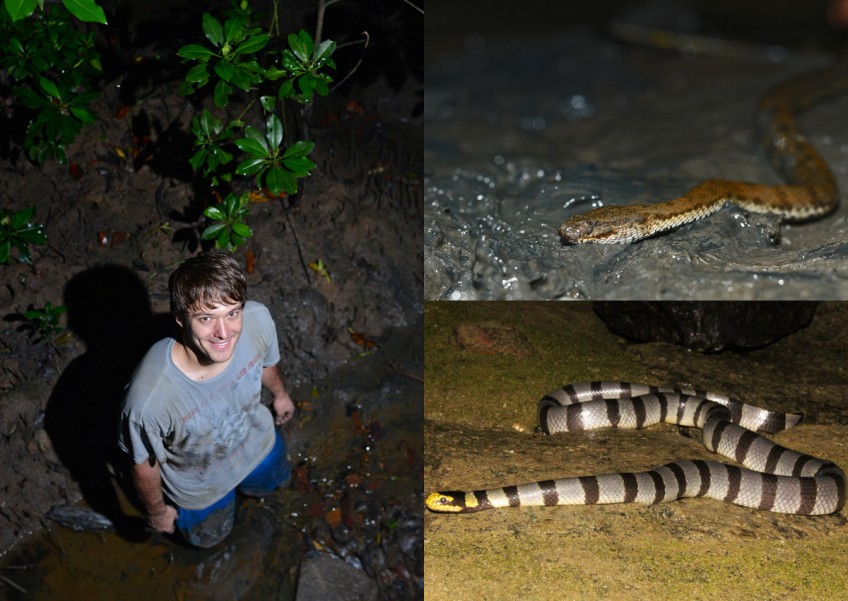US student on snake hunt on local shores


Armed with a torch and camera, 27-year-old Phil Vogrinc wades through mangroves and mud - at times up to waist level - to look for water snakes late into the night.
The student from the United States, who is attending a summer programme at the National University of Singapore (NUS), hopes to understand why some water snake species are found in certain habitats but not in others, and study the impact that rising sea levels could have on them. It is believed to be the first survey of its kind here.
So far, he has found four species here and landed a prize find along the way - the Yellow-lipped Sea Krait, a sea snake that has never been recorded in mainland Singapore before.
Also known as the Laticauda colubrina, the species had previously been sighted only in the Southern Islands. Mr Vogrinc found another off Labrador Park in the early hours of July 22. While the snake is highly venomous, it rarely bites.
"What is truly unique about this observation is that the snake was found on the mainland coastal habitat which is very urban and mostly disturbed," he said.
"The records of this species I have found are from coastal areas or offshore islands with relatively little urban development," he added.
Mr Vogrinc said that the protected rocky shoreline at the western end of Labrador Park could have been used by the snake to forage or even breed.
The US student decided to study snakes here because Singapore lies in the "centre of a biodiversity hot spot" in South-east Asia.
More than 80 snake species can be found in Singapore alone.
Mr Vogrinc has so far spotted more than 200 water snakes of four different species: the dog-faced water snake (Cerberus schneideri), the crab-eating water snake (Fordonia leucobalia), the Gerard's water snake (Gerarda prevostiana) and the Cantor's water snake (Cantoria violacea).
These have been found in places such as West Coast Park, East Coast Park and the mangroves at Pasir Ris Park - which Mr Vogrinc says are "world famous" abodes for them.
He cited renowned naturalist David Attenborough who came to Singapore in 2006 to film the documentary on reptiles and amphibians titled Life In Cold Blood.
The documentary featured the Gerard's water snake devouring a crab by "tearing off" its limbs before eating it.
But beyond documenting snake sightings, Mr Vogrinc hopes to better understand how these snakes could be potentially threatened by rising sea levels.
"The project is an extension of my thesis in the United States where I conducted a similar study on water snakes and their drought tolerance," said Mr Vogrinc, who is pursuing his master's degree at the University of Arkansas.
"What I have learnt is that some species are robust to change and others are not."
Mangroves, where water snakes generally reside, retreat inland due to rising sea levels to maintain their preferred tide depth and salinity.
"In environments like Singapore where mangroves cannot migrate inward due to urbanisation, mangrove ecosystems will likely disappear entirely," said Mr Vogrinc.
Longer dry spells could cause snakes to die of thirst as they are dependent on access to fresh water, said Assistant Professor David Bickford from the NUS' department of biological sciences.
"There are many ways that we think these reptiles might be impacted by climate change, but the most serious ways they might be affected are the ways that we do not understand or have not yet tested," added Prof Bickford.
By the end of his two-month research later this month, Mr Vogrinc would have visited about 25 sites in Singapore to look for these water snakes. They are not just found in mangroves but can also be spotted in canals and drains.
He added: "Most people think of snakes as evil, but they have a life story and purpose just like we do. For animals without arms and legs, it's amazing how successful and widespread they are."
kcarolyn@sph.com.sg

This article was first published on August 11, 2015.
Get a copy of The Straits Times or go to straitstimes.com for more stories.